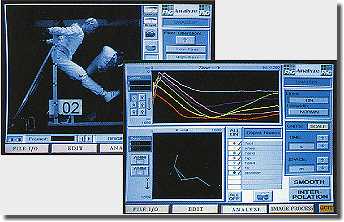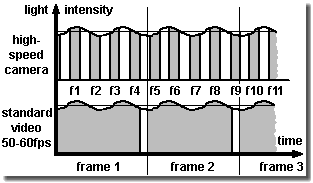Scanning Frequency
Nyquist-Shannon-Kotelnikov Theorem of Sampling

Trajectory evaluation: translation, rotation,
velocity, acceleration and stick-figure animation
Escaping strobe effect is not as simple as it seems. Especially not with a high-speed camera. Illumination sources you would never expect suddenly start to blink. (It seems you do not need a strobe at all. ;-)
Effective or nominal mains voltage of 115 V or 230 V alternates 60 or respectively 50 times per second. Illumination devices directly driven by mains are pumping more or less with this alternating current (AC) frequency of 60 Hertz or 50 Hertz. (1 Hz (Hertz) = 1/sec). Possibly even with 120 or 100 Hertz, because there may be two zero-crossings due to sine oscillation.
Why illumination may flicker
Evidently usual light bulbs or similar illumination
sources are just too sluggish to clearly show the frequency of AC
mains power supply. And of course, our eyes are too slow to
perceive these variations. Also a video camera usually does not
take notice of these flickers.
Even so-called direct current (DC) lamps, where electronics
rectify or smoothen the AC current, can show a certain ripple or
oscillation of higher frequencies a movie or a video camera does
not note, but a high-speed camera of sufficient frame rate does.

Sequence and flickering illumination
That's the cause for a frequent, but incorrect fault report:
»The camera flickers and jitters!
«.
Namely the high-speed camera is definitely not responsible for
that. The reason is connected with the so-called
Nyquist-Shannon-Kotelnikov theorem of sampling, see the figure on
the left. Not until one measures a changing variable with more than
its double frequency, one will be able to reconstruct its curve
shape.
In the figure on the left the video camera runs almost with half
the frequency of the ripple of the illumination source, whereas the
high-speed camera is factor four to five faster again. The gray
areas give the amount of light per frame. The white areas show the
read-out time or inactive phases.
It is clearly to see how ups and downs of the intensity compensate
themselves more or less, the video camera is integrating over them.
Usually this is independent of the phase shift, i.e. the temporal
delay.
The frames of the high-speed camera, however, are exposed with
varying values. The sequence will flicker, when replayed in slow
motion. Something one can often notice in slow motion sequences of
sports event broadcasted on TV under artificial light or directly
the headlights of racing cars, because these are operated
pulsed.
Only if one (strictly) reduces the time of exposure of the video
camera, narrower gray and wider white areas in the figure above,
one will be able to make it flicker as well. With clever adjusted
frequencies (synchronized), however, it may not necessarily
happen.
Using a frame rate of some 100 frames/sec one is able to shoot the
pumping of fluorescent tubes. Therefore this kind of illumination
is not very suitable for high-speed cameras. The sluggish light
bulbs at AC mains are less affected. But merely lamps driven by a
battery (DC current) are really safe from
high-speed cameras.
Stroboscopy and translation
Essential approach is to synchronize the flash
frequency towards the cyclic event, e.g. to m turns + x°.
Flashing at a gear wheel each turn (= 360°) plus x°
results in a progression of x°. Of course, x° can also be
zero, then a frozen image seems to be obtained. (With m turns minus
x° the well-known wagon wheel effect happens, see
below.)
There is the chance, however, to gain much more. The multiple
exposure of an photo - indeed of just one single frame - enables to
shoot a translatory trajectory.
One can carry it to the extremes: just imagine you use a ball
canon to shoot numerous tennis balls against a wall and you
manually make a photo of each shot, thus randomly, without using
automatic triggers like a photoelectric barrier. You receive any
desired plenty of photos showing the individual tennis ball in a
different phase of flight. If you sort the photos according to their
distance between ball and wall you will get a »movie«
with
very high temporal resolution. It is, however, not the trajectory of one
and the same ball. (But there is just no need to mention it. ;-)
Wagon wheel optical illusion
Effect well-known - the coach moves forward, its wheels
turn backward - is a consequence of the sampling theorem as well.
Between two succeeding movie images the wheel rotates by slightly
less than one full turn or at least one or more spoke segment(s).
Or by some full turns whereas the last turn is not completely
finished. That is a special case of the stroboscope effect where
one tries to capture a still image of a rotating object by shooting
integer multiples of a single turn. One's brain interprets these
images then in the wrong way as pseud movement or just as no
movement.
You can perceive the same effect with rotating propellers or
helicopter rotors. (There the rolling shutter effect is evident, see below.)
Rolling shutter artifacts
Extreme strange shots can occur using a rolling shutter,
as provided by many video sensors. Different from the global
shutter (freeze frame shutter) a single frame is not shot at one
and the same time, but some kind of curtain relatively slowly falls
over the sensor. Whereas since the cathode ray tube (CRT) era one
inserts in interlaced mode two of these half-frames (= fields)
separated by 1/50 or 1/60 seconds line by line in each other like a
comb, now there are quite a number of image stripes shot at
different times each single frame is consisting of. Even a
progressive mode 100 Hz or 200 Hz monitor is not able to
suppress this effect afterwards.
As a consequence rotating propeller blades look sickle-shaped,
disappear from time to time or seem to jump fore and back. Also
to use for artistic approach, for example water seeming to stream
down to ground spirally.
Jutter replay
Except for technical defects, there are two causes. At
first the replay rate can be so low that a fluent sequence is not
given. One must offer one's eyes 14 frames/sec at least in order to
prevent them from visualizing the single frames and to keep up the
movie illusion.
On the other hand a very short shutter time (time of exposure; in
each frame x shown in the figure above just one single small gray
column and much white space in between) compared with frame rate or
movement, resp. can cause the movement appearing choppy because too
much location change happens from frame to frame, thus from photo
to photo and so too much is cut out. (Whereby we are at the flip
book again.)
The sometimes odd appearance and alleged strange behavior of small
water waves in movies or on TV are again caused by the
Nyquist-Shannon-Kotelnikov theorem.
